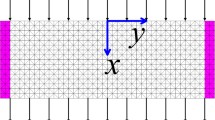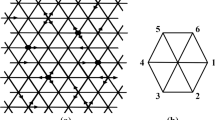Abstract
A lattice gas automaton (LGA) model is proposed to simulate fluid flow in heterogeneous porous media. Permeability fields are created by distributing scatterers (solids, grains) within the fluid flow field. These scatterers act as obstacles to flow. The loss in momentum of the fluid is directly related to the permeability of the lattice gas model. It is shown that by varying the probability of occurrence of solid nodes, the permeability of the porous medium can be changed over several orders of magnitude.
To simulate fluid flow in heterogeneous permeability fields, isotropic, anisotropic, random, and correlated permeability fields are generated. The lattice gas model developed here is then used to obtain the effective permeability as well as the local fluid flow field. The method presented here can be used to simulate fluid flow in arbitrarily complex heterogeneous porous media.
Similar content being viewed by others
Abbreviations
- Clx:
-
correlation length of permeability field inx direction
- Cly:
-
correlation length of permeability field iny direction
- d:
-
diameter of circle, lattice units [L]
- dp/dx :
-
pressure gradient, mass units/lattice unit2×time step2 [m/L2t2]
- e i :
-
unit vector in directioni
- f :
-
drag coefficient
- F k :
-
drag force, mass units×lattice units/time step2 [mL/t2]
- h j :
-
length or the width of thejth composite, lattice units [L]
- k :
-
permeability, lattice units2 [L2]
- k j :
-
permeability of thejth composite, lattice units2 [L2]
- ¯k :
-
effective permeability
- L :
-
length of lattice, lattice units [L]
- m :
-
mass, mass unit
- N i :
-
number of fluid elements at a node with velocity in directioni
- t :
-
time, time steps [t]
- v :
-
velocity, lattice units/time step [L/t]
- v x :
-
velocity in thex direction, lattice units/time step [L/t]
- v ∞ :
-
approach velocity, lattice units/time step [L/t]
- W :
-
width of lattice, lattice units [L]
- X 1 :
-
fraction of permeability component 1
- x :
-
flow direction
- y :
-
normal to the flow direction
- ρ f :
-
fluid density, fluid particle number/equivalent empty node
- ρ s :
-
solid density, solid particle number/node
- Μ :
-
viscosity, fluid particle number/lattice unit×time step [m/Lt]
- f :
-
fluid
- i :
-
iih component
- j :
-
jth component
- s :
-
solid
References
Balasubramanian, K., Hayot, F., and Saam, W. F.: 1987, Darcy's law from lattice-gas hydrodynamics,Phys. Rev. A 36(5), 2248–2253.
Brinkman, H. C.: 1947, A calculation of the viscosity force exerted by a flowing fluid in a dense swarm of particles,App. Sc. Res. A 1, 27–34.
d'Humieres, D. and Lallemand, P.: 1986, Lattice gas automata for fluid mechanics,Physica 140A, 326–335.
Frisch, U., Hasslacher, B., and Pomeau, Y.: 1986, Lattice-Gas Automata for the Navier-Stokes Equation,Phys. Rev. Lett. 56(14), 1505–1508.
Gao, Y. and Sharma, M. M.: 1994, A LGA model for dispersion in heterogeneous porous media,Transport in Porous Media 17, 19–32 (this issue).
Happel, J.: 1965,Low Reynolds Number Hydrodynamics, Prentice-Hall, Englewood Cliffs.
Hayot, F.: 1991, Fingering instability in a lattice,Physica D 47, 64–71.
Kasap, E.: 1990, Analytical methods to calculate an effective permeability tensor and effective relative permeability for cross bedded flow units, PhD dissertation, University of Texas, Austin.
Kirkpatrick, S.: 1973, Percolation and conduction,Rev. Mod. Phys. 45(4), 574–588.
Koplik, J., Lin, C., and Vermette, M.: 1984, Conductivity and permeability from microgeometry,J. Appl. Phys. 56(11), 3127–3131.
Lim, H. A.: 1989, Cellular-automaton simulations of simple boundary-layer problems,Phys. Rev. A 40(2), 968–980.
Mohanty, S. and Sharma, M. M.: 1990, A recursive method for estimating single and mulitphase permeabilities, paper SPE 20477 presented at the 1990 Soc. Pet. Eng. Annual Tech. Conf. and Exhibition, New Orleans, LA, Sept., pp. 23–48.
Riccardi, G., Bauer, C., and Lim, H.: 1991, Boundary and obstacle processing in a vectorized model of lattice gas hydrodynamics,Physica D 47, 281–295.
Rivet, J. P. and Frisch, U.: 1986, Automates sur gaz de réseau dans l'approximation de Boltzmann,CR Acad. Sci. Paris Série 2, 302, 267–272.
Rothman, D. H.: 1988, Cellular-automaton fluids: A model for flow in porous media,Geophys. 53(4), 509–518.
Shah, N. and Ottino, J. M.: 1986, Effective transport properties of disordered, multiphase composites: Application of real space renormalization group theory,Chem. Eng. Sci. 41(2), 283–296.
Stauffer, D.: 1991, Computer simulations of cellular automata,J. Phys. A. Math. Gen. 24, 909–927.
Streeter, V. L. and Wylie, E. B.: 1985,Fluid Mechanics, McGraw-Hill, New York, pp. 258–260.
Wolfram, S.: 1986, Cellular automaton fluids 1: Basic theory,J. Stat. Phys. 45(3/4), 471–526.
Author information
Authors and Affiliations
Rights and permissions
About this article
Cite this article
Gao, Y., Sharma, M.M. A LGA model for fluid flow in heterogeneous porous media. Transp Porous Med 17, 1–17 (1994). https://doi.org/10.1007/BF00624047
Received:
Revised:
Issue Date:
DOI: https://doi.org/10.1007/BF00624047




